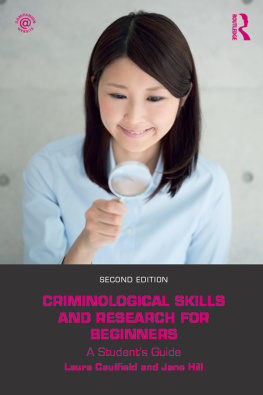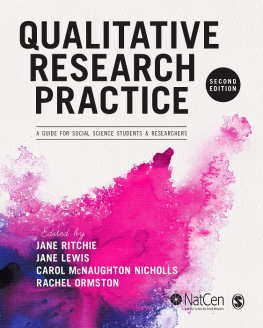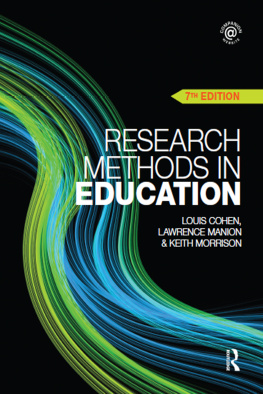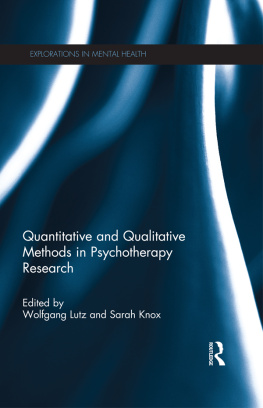Adler, M. J. & Van Doren, C. (1972). How to read a book: The classic guide to intelligent reading . New York: Simon & Schuster.
Bloom, H. (2001). How to read and why . New York: Simon & Schuster.
Bogdan, R. C. & Biklen, S. K. (2007). Qualitative research for education: An introduction to theory and methods (5E). Boston, MA: Allyn and Bacon.
Booth, W. C., Colomb, G. G. & Williams, J. M. (2008). The craft of research (3E). Chicago, IL: University of Chicago Press.
Campbell, D. T. & Stanley, J. C. (1966). Experimental and quasi-experimental designs for research . Boston, MA: Houghton Mifflin.
Chambers, J. M., Cleveland, W. S., Kleiner, B. & Tukey, P. A. (1983). Graphical methods for data analysis . Belmont, CA: Wadsworth.
Clark, C. (2001). BIO 190Writing an abstract. California State Polytechnic University, Pomona. Retrieved from http://www.csupomona.edu/~jcclark/classes/bio190/abstract.html.
Cresswell, J. W. (2011). Educational research: Planning, conducting, and evaluating quantitative and qualitative research (4E). Upper Saddle River, NJ: Prentice Hall.
Crotty, M. (1998). The foundations of social research: Meaning and perspective in the research process . Thousand Oaks, CA: Sage.
December, J. & Katz, S. (2003). Abstracts. Rensselaer Polytechnic Institute. Retrieved from http://www.rpi.edu/dept/llc/writecenter/web/abstracts.html.
Denzin, N. K. & Lincoln, Y. S. (2011). The SAGE handbook of qualitative research . Thousand Oaks, CA: Sage.
Evans, J. D. (1996). Straightforward statistics for the behavioral sciences . Pacific Grove, CA: Brooks/Cole.
Fielding, N. G., Lee, R. M. & Blank, G. (2008). The SAGE handbook of online research methods. London: Sage.
Folks, J. L. (1981). Ideas of statistics . New York: Wiley.
Glaser, B. G. & Strauss, A. L. (1967). The discovery of grounded theory: Strategies for qualitative research. Chicago: Aldine Publishing Company.
Hittleman, D. R. & Simon, A. J. (2005). Interpreting educational research: An introduction for consumers of research (4E). Upper Saddle River, NJ: Prentice Hall.
Hopkins, D. (2002). A teachers guide to classroom research (3E). Buck-ingham: Open University Press.
Hubbard, R. S. & Power, B. M. (2003). The art of classroom inquiry: A handbook for teacher researchers (2E). Portsmouth, NH: Heinemann.
Huck, S. W. (2011). Reading statistics and research (6E). New York: Longman.
Keeley, S. (2003). The Prentice Hall guide to evaluating online resources . Upper Saddle River, NJ: Prentice Hall.
Kies, D. (2003). Writing an abstract. College of Dupage. Retrieved from http://papyr.com/hypertextbooks/engl_102/abstract.htm.
Kincheloe, J. L. (2002). Teachers as researchers: Qualitative inquiry as a path to empowerment (2E). New York: Routledge Falmer.
Kranzler, J. H. (2010). Statistics for the terrified (5E). Upper Saddle River, NJ: Prentice Hall.
Krathwohl, D. R. (2004). Methods of educational and social science research: An integrated approach (2E). New York: Longman.
Lancy, D. F. (1993). Qualitative research in education: An introduction to the major traditions . New York: Longman.
Lincoln, Y. S. & Guba, E. G. (1982). Naturalistic inquiry . Newbury Park, CA: Sage.
McLaren, P. (2006). Life in schools (5E). New York: Longman.
McMillan, J. H. (2011). Educational research: Fundamentals for the consumer (6E). New York: Addison Wesley Longman.
Merriam, S. B. (1998). Qualitative research and case study applications in education . San Francisco, CA: Jossey-Bass.
Miles, M. B. & Huberman, A. M. (1994). Qualitative data analysis (2E). Thousand Oaks, CA: Sage.
Minium, E. W., Clarke, R. C. & Coladarci, T. (1999). Elements of statistical reasoning (2E). New York: Wiley.
Morgan, D. L. (1998). The focus group guidebook . Thousand Oaks, CA: Sage.
Moustakas, C. (1994). Phenomenological research methods . Thousand Oaks, CA: Sage.
Ong, W. J. (1982). Orality and literacy: The technologizing of the word. London: Routledge.
Patton, M. Q. (2001). Qualitative evaluation and research methods (3E). Newbury Park, CA: Sage.
Phillips, J. L. (2000). How to think about statistics (6E). New York: Freeman.
Salsburg, D. (2002). The lady tasting tea: How statistics revolutionized science in the twentieth century . New York: Freeman.
Schreiber, J. B, Stage, F. K., King, J., Nora, A. & Barlow, E. A. (2006). Reporting structural equation modeling and confirmatory factor analysis results: A review. Journal of Educational Research , 99, 323337.
Shank, G. D. (2005). Qualitative research: A personal skills approach (2E). Upper Saddle River, NJ: Prentice Hall.
Siegel, S. & Castellan, N. J., Jr. (1988). Nonparametric statistics for the behavioral sciences (2E). New York: McGraw-Hill.
Spradley, J. P. (1980). Participant observation . New York: Holt, Rinehart & Winston.
Stake, R. E. (1995). The art of case study research . Thousand Oaks, CA: Sage.
Strauss, A. & Corbin, J. (2007). Basics of qualitative research: Techniques and procedures for developing grounded theory (3E). Thousand Oaks, CA: Sage.
Stringer, E. (2004). Action research in education . Upper Saddle River, NJ: Prentice Hall.
Strunk, W., Jr. & White, E. B. (1979). The elements of style (3E). New York: Macmillan.
van Belle, G. (2008). Statistical rules of thumb (2E). New York: Wiley.
Wainer, H. (1992). Understanding graphs and tables. Educational Researcher, 21(1), 1423.
Weinberg, G. H. & Schumaker, J. A (1997). Statistics: An intuitive approach (4E). Belmont, CA: Wadsworth.
Williams, F. & Monge, P. (2001). Reasoning with statistics: How to read quantitative research (5E). Fort Worth, TX: Harcourt.
Wink, J. (2010). Critical pedagogy: Notes from the real world (4E). New York: Addison Wesley Longman.
Wolcott, H. F. (2004). The art of fieldwork (2E). Walnut Creek, CA: Altamira Press.
First published 2014 by Paradigm Publishers
Published 2016 by Routledge
2 Park Square, Milton Park, Abingdon, Oxon OX14 4RN
711 Third Avenue, New York, NY 10017, USA
Routledge is an imprint of the Taylor & Francis Group, an informa business
Copyright 2014, Taylor & Francis.
All rights reserved. No part of this book may be reprinted or reproduced or utilised in any form or by any electronic, mechanical, or other means, now known or hereafter invented, including photocopying and recording, or in any information storage or retrieval system, without permission in writing from the publishers.
Notice:
Product or corporate names may be trademarks or registered trademarks, and are used only for identification and explanation without intent to infringe.
Library of Congress Cataloging-in-Publication Data
Shank, Gary D.
Understanding education research : a guide to critical reading / Gary
Shank, Launcelot Brown, Janice Pringle.
pages cm
Includes bibliographical references and index.
ISBN 978-1-61205-581-7 (pbk. : alk. paper)
ISBN 978-1-61205-639-5 (consumer e-book)
1. EducationResearchMethodology. I. Brown, Launcelot. II. Pringle,
Janice. III. Title.
LB1028.S4395 2014
370.72dc23
2013045264
Designed and Typeset in New Baskerville by Straight Creek Bookmakers.
ISBN 13: 978-1-61205-581-7 (pbk)
ISBN 13: 978-1-61205-580-0 (hbk)
The Role of Research
This book is not only about the role of research in the field of education. More than that, this book is about research not just as a tool for looking at how to understand and improve education, but as a process that is fundamental to education itself.








